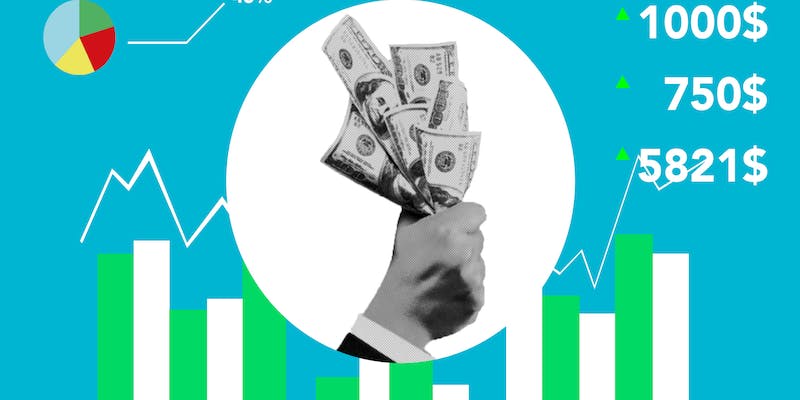How National Debt Can Affect Your Personal Well-Being: A Detailed Look
Triston Martin
Dec 11, 2023
National debt is a country's debt to creditors, primarily the federal government. Past yearly budget deficits—when government spending exceeds revenue—caused it. The U.S. national debt was $33.09 trillion in September 2023. Public services, infrastructure, and budget shortages are financed by borrowing. This borrowing is made possible by government bonds. The U.S. national debt relief comprises public and federal trust fund debt. An economy's debt sustainability is assessed by its debt-to-GDP ratio.
History of National Debt
U.S. debt has fluctuated with critical historical events and economic cycles. It borrowed from abroad to battle for independence during the American Revolution. President Ronald Reagan lowered taxes and expanded spending in the 1980s, raising the debt-to-GDP ratio to 52% by 1990.
After the Great Recession, debt-to-GDP soared from 64% in 2008 to 100% in 2012. This economic downturn increased government spending and lowered tax collections, boosting the national debt to GDP. COVID-19 recently influenced U.S. debt. Economic stimulus initiatives increased spending, pushing the debt-to-GDP ratio from 107% in late 2019 to 135% by mid-2020. In Q1 2023, the ratio plummeted to 119%, illustrating the complex link between history, economic policy, and the national debt.
The nationwide debt to economic production ratio shows the government's ability to pay. The U.S. debt-to-GDP ratio ended Q2 2023 at 120.64%. The federal budget deficit is different from the national debt. The national debt rises owing to periodic deficits, the shortfall between government spending and revenue.
Government Spending

The U.S. government spent $6.27 trillion and ran a deficit in 2022. Government priorities and budgetary commitments are reflected in these allocations. Category breakdown of 2023 federal spending:
- Social Security (23%): Most of the budget supports retirees and disabled individuals.
- Health (15%): Reflects the considerable expenditure on healthcare, surpassing that of other affluent nations.
- Income Security (13%): Includes financial support and security programs for individuals. and families.
- National Defense (13%): Highlights the substantial investment in maintaining a robust defense infrastructure globally.
- Medicare (13%): This signifies the financial commitment to the healthcare program for seniors.
- Net Interest (11%): This represents the interest payments on the federal debt, a crucial budget component.
- Veterans Benefits and Services (5%): Supports programs and services for military veterans.
- Transportation (2%): Allocated for infrastructure and transportation-related projects.
- Other (2%): Encompasses miscellaneous expenditures not covered by the major categories.
In 2023, government spending made up 25% of GDP, which shows that the government had to pay its debts. The fact that the U.S. spends more on healthcare than Germany and the U.K. shows how complicated and important it is. The fact that military spending is higher than the next nine highest spenders shows how committed the country is to security.
Management of National Debt
A congressionally imposed debt ceiling complicates U.S. debt management. The debt ceiling caps borrowing, requiring legislative permission for any amount above it, regardless of earlier allocations. This process provides vital supervision and control over the nation's borrowing capability. Traditionally, government expenditure is cut, and economic growth programs are used to reduce the national debt. These measures restrict deficits and boost income to preserve the fiscal situation. Unsustainable debt levels may force governments to take more harsh actions.
Extreme debtor governments may contemplate drastic alternatives. These include formal debt restructuring, renegotiating debt arrangements, and debt monetization when the government creates money to meet its commitments. A government defaulting on its debt is the worst choice. These dramatic steps are unusual and typically have severe economic implications, but they show how difficult it is for politicians to balance budgetary restraint with financial stability and growth.
Consequences of National Debt
The rising national debt relief has far-reaching effects on interest rates. The Congressional Budget Office (CBO) predicts rising net interest expenses for the U.S. government as the debt grows. By 2032, these prices are expected to quadruple to $1.2 trillion. Policymakers have difficult choices due to increased interest rates. Lawmakers must choose between permitting more significant deficits, cutting expenditure, and raising income. Economic navigation depends on this decision-making process.
Effects of National Debt

The national debt, like personal debt, impacts people economically. A government like the U.S. may pay its bills in its currency, giving it more financial flexibility than a household. Government debt affects people beyond its actual size and debt-to-GDP ratio. How borrowed money is used frequently becomes more important than the debt relief. America backed pandemic relief funding while rejecting changes to expensive government programs during the COVID-19 epidemic. This contradiction shows how complicated public opinion on government borrowing is.
The paradox of thrift shows that saving more individually might have unintended consequences. Fiscal austerity measures taken by governments during economic uncertainty can exacerbate recessions, increasing deficits and debt. This shows how government policies affect economic dynamics. Debt and service expenses force lawmakers to make difficult decisions that affect citizens. During COVID-19, the government borrowed for pandemic relief and financial support.
The public's support of this borrowing shows that crisis expenditure was necessary. Many believe they pay too much in federal income tax and support higher taxes for companies and the rich. National debt affects how borrowed monies are invested. Government borrowing can provide returns more significant than expenses if used to boost productivity. This depends on investment efficiency and efficacy. The impact of national debt on individual well-being depends on these investments.
The effects of national debt on people are complex. Individual families lack the flexibility of a government managing debt in its currency. Government policy, popular mood, and borrowing funds influence the economy. The complex link between government debt and citizen well-being highlights the necessity of fiscal management and intelligent investments in supporting a strong and resilient economy.
Bottom Line
A U.S. debt default raises political and financial stakes, putting politicians and markets in danger. Breaching the debt ceiling may devastate the nation's finances. The ceiling must be submitted, necessitating delicate talks and strategic considerations. The convergence of political dynamics and economic imperatives emphasizes the significance of appropriately managing the national debt to avoid a scenario with far-reaching domestic and global consequences.







